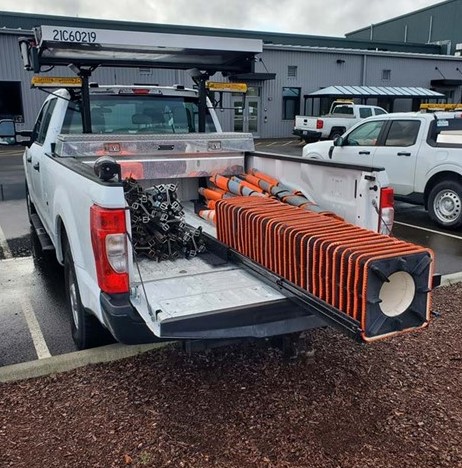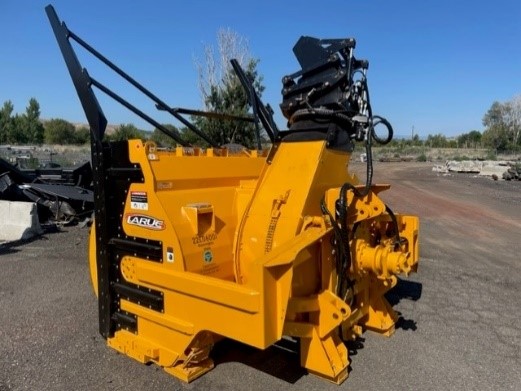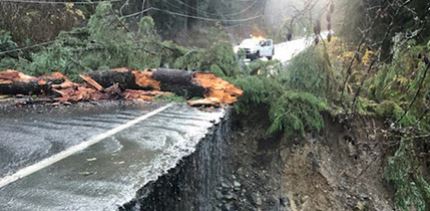Highway maintenance - Winter operations & extreme events
On this page:
Winter operations & extreme events
Snow and ice plans
WSDOT crews start working long before snowflakes fall to keep roads open during inclement weather. The agency uses advanced weather forecasting to predict where snow and ice will accumulate and use the information to pre-treat high traffic corridors. The anti-icing chemicals used by WSDOT help prevent frost and ice from bonding to the pavement. Once snow has started falling and accumulating, crews switch to a salt pre-wet with a corrosion-inhibited liquid deicer that helps snow and ice to melt, making it easier to remove with snowplows—but it takes time to work.
Avalanche control
WSDOT's Avalanche Forecasting and Control team is a dedicated crew of experienced professionals who monitor the weather and snow to determine when avalanches may occur. The crew is split into two regional teams with full-time employees and seasonal employees. The Avalanche Control Supervisor for each team leads the crew throughout the year.
When conditions indicate an avalanche is imminent, teams employ various methods and tools to bring down unstable snow in a controlled manner. The team works throughout the fall, winter, and spring along Washington's mountain highways.
Performance Analysis
2024
WSDOT winter operations prepare proactively and reactively
In the 2023/2024 winter season, Washington transitioned out of the La Nina pattern after three years and into a typical El Nino winter. Generally, this means that temperature was above normal and precipitation was generally normal or higher than normal. In the 2023/2024 winter season temperatures were above normal on average, with precipitation approximately normal. Most snowpacks were well below normal, typically between 70-80%.
In addition to the agency's snow and ice plans, WSDOT uses advanced weather forecasting tools to form predictions of where snow and ice may accumulate. WSDOT's response to snow and ice can be both reactive and proactive, using treatment of roadways with corrosion-inhibited chemical deicers and mechanical removal. Snow and ice control treatment outcomes vary, depending on the severity of winter weather events, topography, traffic levels and speeds, and proximity to support facilities (i.e., liquid chemical storage tanks and salt stockpiles).
Chemical deicers are used in anti-icing applications to help prevent snow and ice from bonding to the roadway. When used reactively in response to accumulating snow or ice on the roadway, chemical deicers help melt snow and ice in conjunction with plowing. WSDOT's goal is to return roadways to bare and wet conditions during and after inclement weather. On high-priority roadways, operations continue until bare pavement is achieved. On other roadways, the goal is to return pavement to bare and wet conditions as soon as practical.
Maintenance Operations ingenuity leads to new innovations
WSDOT employees commonly find innovative solutions to ordinary problems they encounter to save time, resources and be more efficient in accomplishing tasks. WSDOT's Innovation Challenge allows maintenance employees to participate in and share their solutions with others across the state. Since 2018, the challenge has shared many innovations that make day-to-day tasks easier, faster and safer.
1st place winner of the 2024 Innovation Challenge is - Traffic Cone Slide Drawer by Joseph Veltri, Olympic Region Work Zone Crew

The Traffic Cone Slide Drawer addresses a common but critical safety issue: the risk to employees who need to retrieve traffic cones from the back of a truck while in active work zones. The device allows employees to access the cones quickly and safely without climbing up and down from the truck bed or over the tailgate. This innovation reduces exposure to hazards and improves overall safety for field crews. The invention won first place and earned the Maintenance Operations Director Safety Award and was voted the People's Choice Award at the statewide maintenance manager's meeting.
WSDOT celebrates innovation and efficiency
WSDOT's Innovation Challenge is a platform for staff to present their solutions to make tasks safer, faster, and more efficient. In addition to the individual recognition and cash rewards—up to $5,000 for their maintenance area budget to purchase new equipment or personal protective gear—these winners contribute to the ongoing improvement of WSDOT's operations.
2023
WSDOT winter operations prepare proactively and reactively
In combination with the agency's snow and ice plans, WSDOT uses advanced weather forecasting tools to form predictions of where snow and ice may accumulate. WSDOT's response to snow and ice can be both reactive and proactive using treatment of roadways with corrosion inhibited chemical deicers and mechanical removal. Outcomes of snow and ice control treatments vary, depending on the severity of winter weather events, topography, traffic levels and speeds, and proximity to support facilities (i.e. liquid chemical storage tanks and salt stockpiles).
Proactively, chemical deicers are used in anti-icing applications help prevent snow and ice bonding to the roadway. When used reactively in response to accumulating snow or ice on the roadway, chemical deicers help melt snow and ice in conjunction with plowing. WSDOT's goal is to return roadways to bare and wet conditions during and after inclement weather. On high priority roadways, operations continue until bare pavement is achieved. On other roadways, the goal is to return pavement to bare and wet condition as soon as practical.
Farming ingenuity leads to new innovations
Innovation happens every day at WSDOT. Employees find solutions to ordinary problems they encounter to save time, resources and be more efficient in accomplishing a task. WSDOT's Innovation Challenge is an opportunity for maintenance employees to participate in and share their solutions with others across the state. Since 2018, the challenge has shared many innovations that make day-to-day tasks easier, faster and safer.
Widespread damage to snowblower heads across the state contributed to the closure of several mountain passes, affecting travel for thousands of people. Ernie Sims, WSDOT's statewide fleet administrator, is also a wheat farmer in Reardon. Sims put on his farming hat and brainstormed possible solutions to the problem. He worked with manufacturer Larue to develop a snowblower head that WSDOT could easily change out with minimal downtime when damaged. As a result, new snowblowers are being delivered nationwide that have quick disconnect heads that can be changed out in a matter of hours instead of weeks (if not the rest of the winter season) to fix.

2022
WSDOT looks to shore up shortages and gaps
WSDOT faces the challenge to deliver a resilient and resourceful maintenance program that has become exacerbated by the national and global supply chain shortages and material gaps for many commodities.
These shortages and gaps make it difficult for the Transportation Equipment Fund program (TEF) to locate repair parts, tools, shop equipment, vehicles, and heavy equipment. The program has been innovative to meet the fleet's needs and every effort is being made to keep the fleet operational and replace equipment innovatively. New equipment brands are being introduced into the TEF fleet and contracts have been made with a more diverse vendor base. In the end, the solutions enacted by WSDOT to overcome the global supply chain issues have led to a more resilient TEF fleet.
2021
Tow plows tackle double duties
WSDOT's Eastern Region is home to the agency's three tow plows. These plows are designed to be towed and extended out at an angle behind a plow truck to clear a secondary lane at the same time. Tow plows, when angled, have a 14-foot clearing path.
These plows are also equipped with a granular spreader and liquid tanks to apply deicing materials. The combination of the tow plow with the materials application allows a single truck to perform the work of two trucks, clearing two lanes at once. Tow plows not only clear the roadway faster, but also reduce the cost of the operations.
The three tow plows in Eastern Region have nicknames as part of a public engagement campaign. This light-hearted campaign has yielded serious results—including increased public engagement about WSDOT's plowing work and extending the reach of plow safety messaging to a broader audience.
The plows are named:
- Plowie McPlow Plow
- The Big Leplowski
- Sir Plows-a-Lot
Naming each tow plow has become a tradition of sorts, with the agency allowing the public to submit suggestions each time a new tow plow is added. Staff then narrow it down to a smaller list before putting the name up to a vote on social media.
WSDOT faces ongoing struggle to meet maintenance staffing needs
WSDOT is working to rebound from a hiring freeze that accompanied Initiative 976 as well as continued retirements, recruitment/retention struggles and COVID-19 restrictions that furthered staffing shortages while increasing training time for new employees.
Pandemic-related revenue decreases that left WSDOT unable to hire in 2020 continued into July 2021. Recruitment efforts increased at that time but were affected by the mandatory vaccine requirement for state employees, which resulted in the loss of trained personnel both in Maintenance and the Transportation Equipment Fund (motor pool and mechanics).
WSDOT continues to recruit for vacancies created by various factors, including an aging workforce and several pandemic-related circumstances including: furloughs, hiring freezes, temporary instead of permanent hires, vaccine mandates, and increased competition for workers with diesel mechanic qualifications or commercial driver licenses (CDL).
The CDL issue, is partly due to a pandemic-related spike in the demand for CDL truck drivers, which affected all states in 2021. As a result, WSDOT aligned workload expectations with available staffing levels. While it shifted resources wherever possible, it also could not push its crews beyond safe workloads.
Staffing levels affect WSDOT's statewide winter operations
With the pandemic affecting winter operations for the second year in a row, WSDOT's winter operations staff was down 19.5% from approximately 1,500 to roughly 1,200. Maintenance was already down 142 positions as of October 1, 2021.
After the October 18, 2021 vaccination mandate, another 151 staff in those positions resigned or retired from the agency, leaving a total of 293 winter operations positions unfilled—more than four times what it was the year prior.
Maintenance responds to extreme events statewide
WSDOT's planned maintenance activities come to a halt when an emergency or disaster occurs because crews must first respond to potential hazards that threaten Washington's transportation infrastructure. These types of emergency responses divert maintenance crews from scheduled work as they must assist with road closures and traffic control and, in some cases, begin initial repairs. These unfunded emergencies exacerbate the maintenance backlog because they take personnel away from planned activities.
The summer of 2021 marked a historic heat wave that affected the state's infrastructure and roads, causing pavement damage across the state. During the late-June and early-July heat wave, regions across the state experienced multiple days at well above 100 degrees Fahrenheit which resulted in buckling and peeling pavement. WSDOT crews responded to 26 extreme heat-related issues across the state.
Landslides, washouts, and cleanup due to heavy rains and previous fire damage also affected Washington's roadways in 2021, including long-term closures in some locations. In total, WSDOT crews responded to 41 landslides.
US 101 south of Forks landslide due to November storm
A large landslide closed US 101 at milepost 185 near Forks after a storm on November 15, 2021. The slide affected approximately 50 feet of roadway while three smaller embankment failures filled a ditch with debris and trees, clogging a nearby culvert and causing water to spill onto the roadway. Maintenance crews were able to clear downed trees, debris and water, and install a jersey barrier in the center of the roadway to reopen access to Forks. Crews restored one-way, alternating travel near Kallman Road on Wednesday, November 17 after two days of work. An emergency contract is being prepared for a long-term fix of the site. Smaller slides on SR 113 and SR 110 were cleared in the days that followed.

2020
COVID-19 impacts on 2020-21 winter service
While safety remains the agency's top priority during the COVID-19 pandemic, the heightened need to be strategic with both overtime hours and materials may mean that roads and passes are closed more frequently during large storms, and that those closures may last longer.
Tire chains may also be required more often as reduced crews may be able to keep roads open but not completely clear of snow or ice. Lower priority roads might also go untreated for longer periods of time while available crews focus on high priority, more heavily traveled routes. For the safety of crews and travelers, roads that cannot be maintained will be closed until the weather situation resolved.
